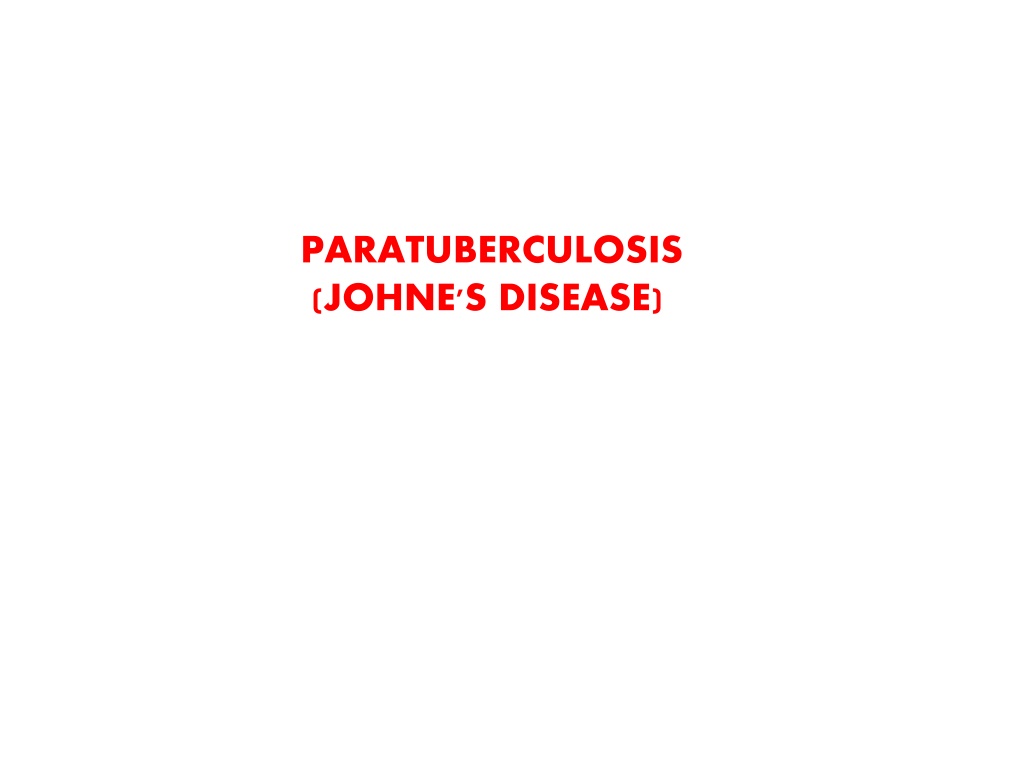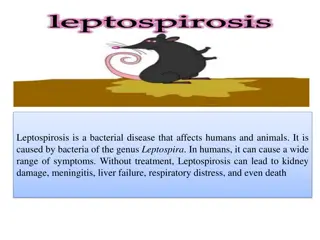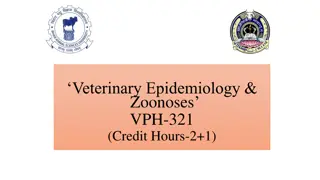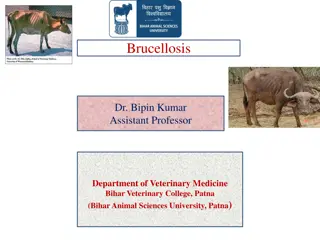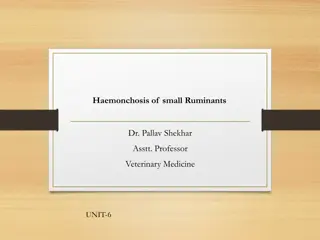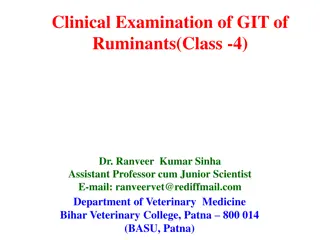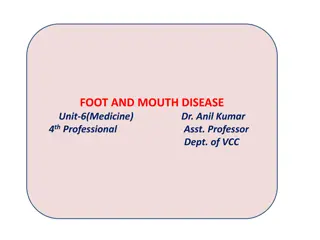Understanding Paratuberculosis (Johne's Disease) in Animals
Contagious and fatal, Paratuberculosis, or Johne's Disease, affects the small intestine of ruminants due to Mycobacterium avium subspecies paratuberculosis. It spreads through fecal-oral route, affecting animals' immunity, causing weight loss, decreased milk production, and diarrhea. The infection leads to thickening of intestines, malabsorption, and eventual cachexia, resulting in severe consequences for infected animals.
Download Presentation

Please find below an Image/Link to download the presentation.
The content on the website is provided AS IS for your information and personal use only. It may not be sold, licensed, or shared on other websites without obtaining consent from the author. Download presentation by click this link. If you encounter any issues during the download, it is possible that the publisher has removed the file from their server.
E N D
Presentation Transcript
PARATUBERCULOSIS (JOHNE'S DISEASE)
INTRODUCTION A contagious, chronic and sometimes fatal infection that primarily affects the small intestine of ruminants and is caused by the bacterium Mycobacterium avium subspecies paratuberculosis (MAP).
Transmission By the fecal oral route. Infected animals can shed large numbers of organisms in the feces. Can also be excreted through by colostrum, milk, udder, and the male and female reproductive tracts. Transmission can occur on fomites, and insects may act as mechanical vectors. The incubation period is usually months or years, Calves generally become infected soon after birth but rarely show clinical signs before they are two years old.
PATHOGENESIS The primary site targeted by Johne's disease is the ileum. The wall of the ileum contains, lymphoid tissue known as Peyer's patches. Covering Peyer's patches are a layer of cells called M cells. These M cells pass antigens (bacteria) through to the underlying cells of the Peyer's patch to "show" these antigens to the macrophages and lymphocytes. Inside a macrophage, M. paratuberculosis multiplies until it eventually kills the cell, spreads and infects other nearby cells.
The animal's immune system reacts by recruiting more macrophages and lymphocytes to the site of the infection. The lymphocytes release cytokines, in an attempt to increase the bacterial killing power of the macrophages. Macrophages fuse together, forming multinucleated giant cells, what is called granulomatous inflammation. Infiltration of infected tissues with millions of lymphocytes and macrophages leads to visible thickening of the intestines. This, among other factors, leads to malabsorption. Thus, lose body condition, milk production drops off, and diarrhea may occur. In effect, an animal with Johne s disease is starving in spite of having a good appetite and eating well.
CLINICAL SIGNS IN CATTLE Most cases are seen in 2 to 6 year old animals. Initially weight loss, decreased milk production or roughening of the hair coat. The diarrhea is usually thick, without blood and may be intermittent at first and consistent later. Tenesmus is not seen. Intermandibular (BOTTLE JAW) or ventral edema may occur. The temperature and appetite are usually normal and animals are alert. Affected animals become increasingly emaciated and usually die as the result of dehydration and severe cachexia .
IN GOATS Diarrhea is less common than in cattle. The infection occurs in kids in the first months of life, but signs of disease usually do not appear until the animals are adults. Despite continuing to eat well, adult goats become emaciated and weak. The clinical signs are similar in other ruminants. In sheep the wool is often damaged and easily shed, and diarrhea is less common than in cattle.
Lesions Histologically, the lesions are characterized by diffuse granulomatous enteritis, with the accumulation of epithelioid macrophages and giant cells in the intestinal mucosa and submucosa. Acid-fast organisms may be found inside macrophages. Similar lesions occur in sheep and goats. The mucosa is often only slightly thickened in these species, but caseated or calcified nodules are sometimes found in the intestines and associated lymph nodes. http://t1.gstatic.com/images?q=tbn:ANd9GcSlLxlbTOKp2K3t_vX3OcCEEfJMEmch6Ha9tPJ80ucTtkjVtHcamP1YGns
Morbidity and mortality The mortality rate is approximately 1%, but up to 50% of the animals in the herd can be asymptomatically infected, resulting in losses in production. Once the symptoms appear, paratuberculosis is progressive and affected animals eventually die.
Post Mortem Lesions The carcass may be thin or emaciated. Dependent edema and fluid may be found in the body cavities. The characteristic lesion is a thickened, often corrugated, wall in the distal small intestine. In more advanced cases, the lesions can extend from the duodenum to the rectum. The mucosa is not ulcerated. Discrete plaques may be seen early in the disease. The mesenteric lymph nodes and other regional nodes are often enlarged and edematous.
Diagnosis Microscopy - Ziehl Neelsen stains can be used to detect M. avium subsp. paratuberculosis in the feces; clumps of small, strongly acid-fast bacilli are diagnostic. Organisms may also be found in smears from the intestinal mucosa or the cut surfaces of lymph nodes. Culture -Bacteria can be cultured from the feces, thickened areas of the intestinal wall, and ileal, mesenteric and ileocecal lymph nodes. Suitable media include Herrold s egg yolk medium, modified Dubos s medium and Middlebrook 7H9, 7H10 and 7H11 media; mycobactin is necessary for bacterial growth. M. avium subsp. paratuberculosis grows slowly; colonies may take 5 to 14 weeks to appear.
Zoonotic Importance In humans, an ailment called Crohn's disease that resembles Johne's disease. Crohn s disease is a chronic inflammatory bowel disease (IBD) that has no known cause and no known cure. But being linked with MAP species.
